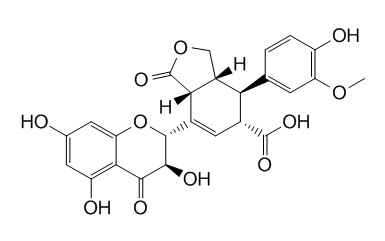Silyamandin
Silyamandin may have antihepatotoxic and chemopreventive activities.
Inquire / Order:
manager@chemfaces.com
Technical Inquiries:
service@chemfaces.com
Tel:
+86-27-84237783
Fax:
+86-27-84254680
Address:
1 Building, No. 83, CheCheng Rd., Wuhan Economic and Technological Development Zone, Wuhan, Hubei 430056, PRC
Providing storage is as stated on the product vial and the vial is kept tightly sealed, the product can be stored for up to
24 months(2-8C).
Wherever possible, you should prepare and use solutions on the same day. However, if you need to make up stock solutions in advance, we recommend that you store the solution as aliquots in tightly sealed vials at -20C. Generally, these will be useable for up to two weeks. Before use, and prior to opening the vial we recommend that you allow your product to equilibrate to room temperature for at least 1 hour.
Need more advice on solubility, usage and handling? Please email to: service@chemfaces.com
The packaging of the product may have turned upside down during transportation, resulting in the natural compounds adhering to the neck or cap of the vial. take the vial out of its packaging and gently shake to let the compounds fall to the bottom of the vial. for liquid products, centrifuge at 200-500 RPM to gather the liquid at the bottom of the vial. try to avoid loss or contamination during handling.
Heliyon.2024, 10(7):e28755.
Int J Mol Sci.202, 25(17):9246.
Research Square2021, 10.21203.
J Tradit Chin Med.2023, 43(6):1081-1091.
Biol. Life Sci. Forum2024, 35(1), 6.
Oncol Rep.2021, 46(1):143.
Nutrients.2022, 14(16):3393.
Int J Mol Sci.2020, 21(7):2530.
Drug Chem Toxicol.2024,1-12.
Environ Toxicol.2024, tox.24246
Related and Featured Products
Curr Pharm Des. 2015;21(38):5489-500.
"Non-Taxifolin" Derived Flavonolignans: Phytochemistry and Biology.[Pubmed:
26429716 ]
Flavonolignans are plant natural products, composed of a flavonoid moiety and a lignan (phenylpropanoid) part. Current literature focuses on flavonolignans formed from taxifolin and coniferyl alcohol as e.g. silybin and its congeners from fruit extract from the purple variety of the milk thistle (Silybum marianum) denoted as "silymarin".
METHODS AND RESULTS:
This review describes chemistry and biological activity of so far neglected "non-taxifolin" based flavonolignans, derived from apigenin, luteolin, tricin, chrysoeriol, naringenin and eriodictyol, as the flavonoid part. Up-to-date knowledge on hydnocarpin, hydnocarpin-D, pseudotsuganol, hydnowightin, neohydnocarpin, palstatin, salcolins A and B, anastatins A and B, sinaiticin, Silyamandin and silandrin is summarized in the present paper. Most of non-taxifolin derived flavonolignans have been shown to exhibit in vitro and/or in vivo anti-hepatotoxic, anti-oxidant, free radical scavenging, anti-inflammatory, anti-proliferative, anti-cancer, chemotherapy potentiating, anti-melanogenic, anti-bacterial, vasorelaxing, anti-platelet aggregation and/or hypotriglyceridemic activity, often stronger than silybin. Many of these compounds inhibited Staphylococcus aureus multidrug resistance pump NorA and sensitized multidrug resistant cancer cell lines showing a potential as adjuvants. Non-taxifolin derived flavonolignans are a relatively unexplored group of compounds with interesting biological activity and great application potential.
CONCLUSIONS:
Their detailed study could provide a new insight into the biomimetic synthesis in order to obtain new compounds with greater activity and identify new lead structures for the biomedicinal research.
Fitoterapia. 2017 Jun;119:175-184. d
Chemotaxonomic and biosynthetic relationships between flavonolignans produced by Silybum marianum populations.[Pubmed:
28392269 ]
Flavonolignans constitute an important class of plant secondary metabolites formed by oxidative coupling of one flavonoid and one phenylpropanoid moiety. The standardized flavonolignan-rich extract prepared from the fruits of Silybum marianum is known as silymarin and has long been used medicinally, prominently as an antihepatotoxic and as a chemopreventive agent.
METHODS AND RESULTS:
Principal component analysis of the variation in flavonolignan content in S. marianum samples collected from different locations in Egypt revealed biosynthetic relationships between the flavonolignans. Silybin A, silybin B, and silychristin are positively correlated as are silydianin, isosilychristin, and isosilybin B. The detection of Silyamandin in the extracts of S. marianum correlates with isosilychristin and silydianin content. The positive correlation between silydianin, isosilychristin, and Silyamandin was demonstrated using quantitative 1H nuclear magnetic resonance spectroscopy (qHNMR).
CONCLUSIONS:
These correlations can be interpreted as evidence for the involvement of a flavonoid radical in the biosynthesis of the flavonolignans in S. marianum. The predominance of silybins A & B over isosilybin A & B in the silybin-rich samples is discussed in light of the relative stabilities of their respective radical flavonoid biosynthetic intermediates.



